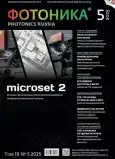Parameter Selection Methods for the Basic Range Sensors and Determination of Its Range Characteristic
- Authors: Ostanin M.V.1, Otkupman D.G.2, Shakhmatov M.V.1
-
Affiliations:
- Impulse Research and Production Company
- Moscow State University of Geodesy and Cartography
- Issue: Vol 19, No 5 (2025)
- Pages: 390-399
- Section: Optical-Electronic Systems & Complexes
- URL: https://journals.eco-vector.com/1993-7296/article/view/690097
- DOI: https://doi.org/10.22184/1993-7296.FRos.2025.19.5.390.399
- ID: 690097
Cite item
Abstract
The parameter selection methods for the onboard basic automatic active optical range sensors and determination of its range characteristic are considered. The paper provides for the dependences and influence of the base value, focal distance and the circle of confusion value on the relative response error of range sensors, as well as selection of these parameters at a given relative error and response distance. The models and optical circuits of the sensors based on a photo- and laser diode developed according to the established method are shown.
Full Text
About the authors
Mikhail V. Ostanin
Impulse Research and Production Company
Author for correspondence.
Email: ost@impuls.ru
Head of Department
Russian Federation, MoscowDmitry G. Otkupman
Moscow State University of Geodesy and Cartography
Email: odvk@ya.ru
ORCID iD: 0000-0003-0054-3155
PhD Student, Senior Lecturer at the Department of Optical Electronic Devices
Russian Federation, MoscowMikhail V. Shakhmatov
Impulse Research and Production Company
Email: svm@impuls.ru
Сand. of Sc. (Techn.), Senior Researcher, Chief Designer
Russian Federation, MoscowReferences
- Miroshnikov M. M. Theoretical foundations of optical-electronic devices. – M.: Lan’, 2010. 704 p. (In Russ.). ISBN 978-5-8114-1036-1.
- Krylov K. I., Prokopenko V. T., Mitrofanov A. S. Application of lasers in mechanical engineering and instrument making. – L.: Mashinostroenie, 1978. 336 p. (In Russ.)
- Khokhlov V. K., Gurkin R. V. Model of backscatter interference as applied to laser pulse range sensors. Defense technology. 2005; 4–5:56 (In Russ.).
- Khokhlov V. K., Gurkin R. V. Quasi-optimal regressive algorithm for range measurement in pulsed short-range ranging systems. Defense technology. 2006;1–2:100 (In Russ.).
- Musyakov M. P., Mitsenko N. D. Optical-electronic systems for short-range ranging. –M.: Radio i svyaz’, 1991. 166 p. (In Russ.)
- Borzov A. B., Tsisarsky A. D. Stability of the operating range of an optical distance sensor. Defense technology. 2006;9:36–42. (In Russ.)
- Ostanin M. V. Dependence of the relative error of a basic type range sensor on the parameters of the optical system. News of higher educational institutions, section “Geodesy and aerial photography”. 2012;5:106–109 (In Russ.).
Supplementary files















